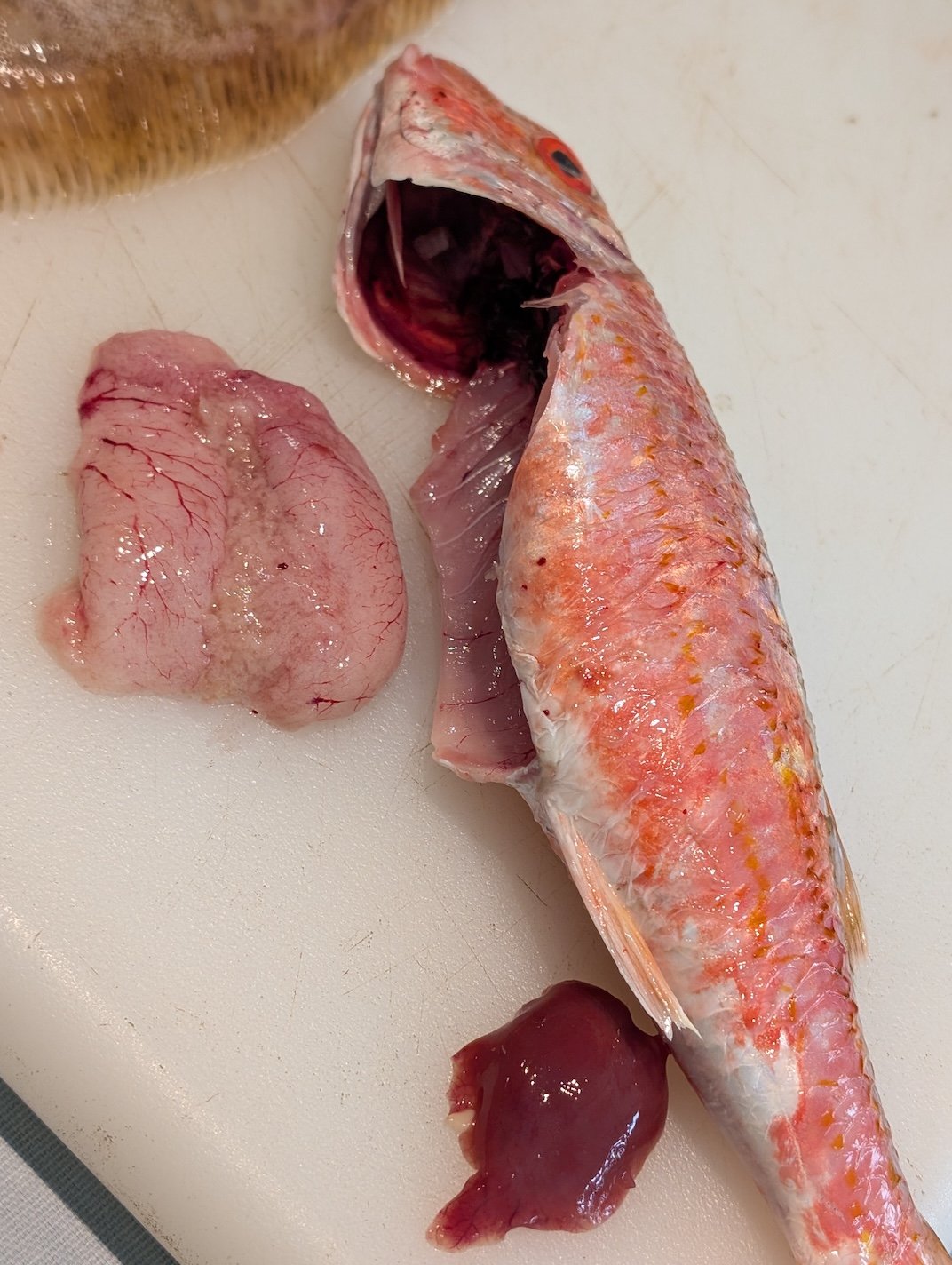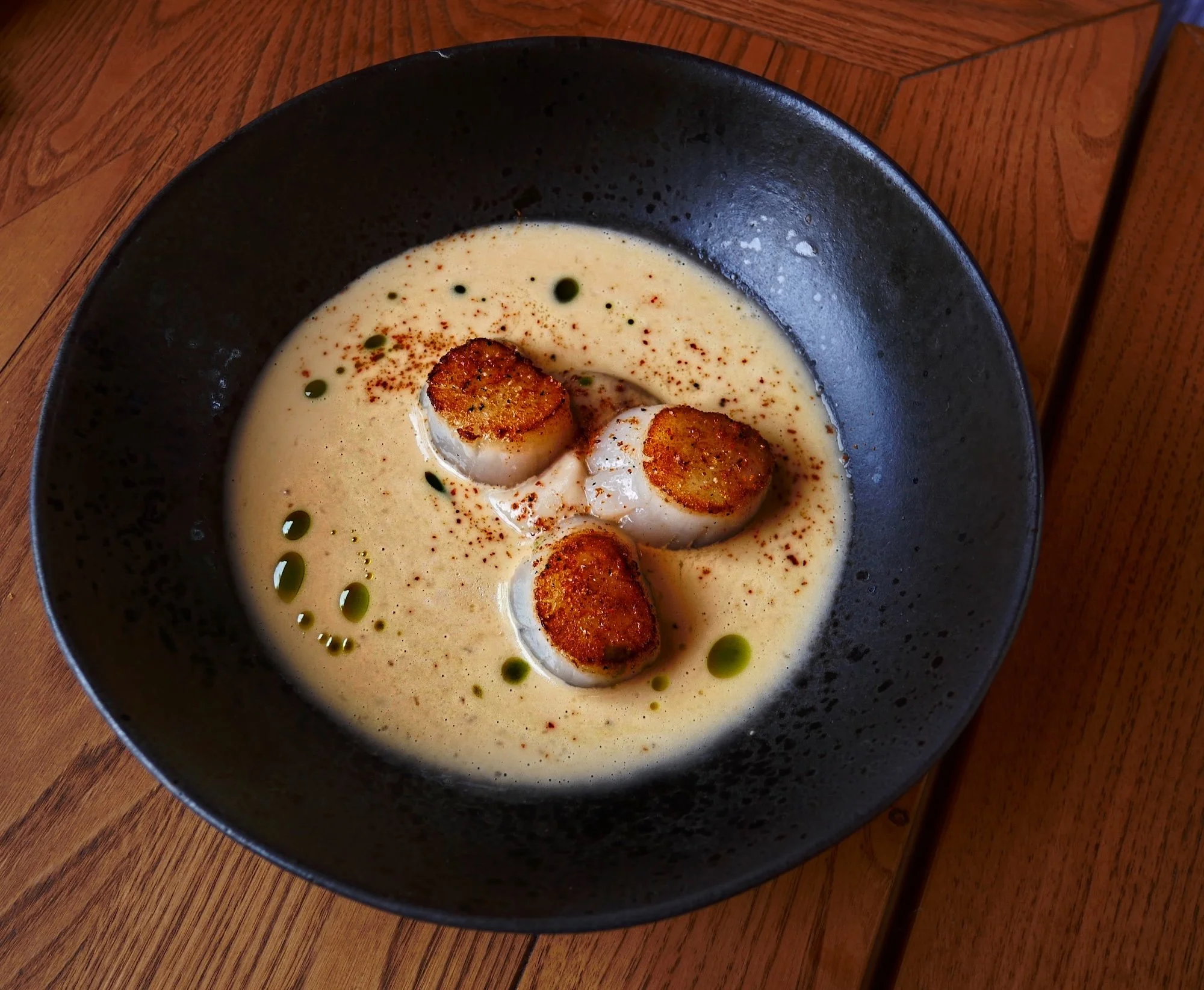Mastering Fish Cookery with Annie Seabourne at My Fish Kitchen in Cornwall
Learning the Art of Fish Cookery with Annie Seabourne
How many of us home-cooks think we know our way around a fish? Really know it, I mean, so that we can clean, gut and fillet any kind of swimming creature that is about to bless our dinner tables?
My guess is there’ll be a smallish number who’ll feel confident when confronted with any kind of raw seafood, but also a majority who will look at different kinds of fish and wish they were at the chip shop buying something deep fried and free of bones.
Red mullet with roe and liver
I would place myself in the first group, although having said that I can report that I am now 100 percent more knowledgeable than I was just a week ago. Why? Because although I thought I knew most kinds of fish, I didn’t.
A Seafood Cookery Course in Mawnan Smith
I learned this truth after I spent two days with my new pal and seafood mentor, Annie Seabourne. A Cornish fisherman’s daughter with many years of experience working in the fishing industry, Annie now runs her own seafood cookery school, called My Fish Kitchen. Which is an accurate description, because it is actually based in Annie’s own kitchen in her small cottage in the village of Mawnan Smith - and the one thing she specialises in is teaching people about the edible delights of the sea.
Annie Seabourne in her My Fish Kitchen
Learning from a Cornish Fish Expert
Could I fillet a fish before I met Annie? Yes. Could I do it well? No. Did I know the different cuts and techniques you need to make a good job of different kinds of fish? Definitely not. Now I do. If I can remember them all, which is doubtful for me with a brain like a sieve. However, I am likely to remember the basics.
Because that is what Annie is very good at teaching. Even though I spent a day-and-a-half at My Fish Kitchen, what we did was to simply cover the basics. In such a short time, how could you glean the entire knowledge of someone who’s spent the best part of 40 years in the fish trade? Annie began her career by setting up her own business selling seafood in Cornwall - and as such she is a walking encyclopaedia of all things marine and edible.
Mackerel fillets and liver beginning to fry
Hands-On Seafood Skills: Filleting, Squid, Stock & More
The sessions were practical, allowing for a direct engagement with various types of fish and their preparation. The curriculum covered different methods of cooking and handling seafood. The instruction was clear and focused on developing a basic proficiency and, as I say, my understanding of fish preparation expanded enormously.
Annie’s instructions included details on selecting fresh fish as well as exacting details on the various techniques for filleting. We worked with a range of local species, gaining experience with their individual characteristics. On our first four-hour day we looked at fresh mackerel, red mullet, whiting, lemon sole and John Dory - we also dealt with squid and we made a simple but fabulous fish stock. On the second morning we went on to deal with lobster and brown crab.
Dealing with a fresh cooked lobster
Annie’s Filleting Techniques and Fish Wisdom
Each of the fish required a different filleting technique. Of course, saying that, you do not have to fillet any of them. Cooking them whole is excellent for flavour, but there are a good many folk who would prefer their fish with no pesky bones - and at least by filleting something like a lemon sole you can use its carcass to make a good stock.
I was amazed by the different cuts Annie showed me. For example, there are certain little swipes with the sharp knife you can use around the neck area to release an entire fillet, but you need to know exactly how and where. To give another example, there’s another kind of knife action with a flat fish which sees the filleter jabbing the point directly down between the flat bone structure and the rear of the fish - angle the blade out towards the edge and you can work your way along to release a wonderfully clean fillet.
Filleting a Cornish mackerel
Cornish Knowledge Passed Down Generations
A Falmouth fisherman’s daughter, Annie was literally born to work in the Cornish seafood industry. In her kitchen she demonstrates techniques learned from her lifetime of experience, explaining and demonstrating each step so that I, as the pupil, could replicate the process. This hands-on approach allowed me to get to grips with the feel of each fish - and, believe me, they are all quite different.
Simple Seafood Cookery: Less is More
In short, I reckon Annie must be one of the UK’s best teachers when it comes to basic fish and shellfish preparation. If you don’t know the basics, then it’s difficult to fly to higher places, and Annie covers the rudimentary seafood knowledge with great gusto and aplomb. As and when we’d finish with a fish, she’d then cook it in some way or other, but always with maximum simplicity. Needless to say, I consumed a large quantity of delicious seafood on both days.
Simply floured: lemon sole
Keeping things simple is the best way to cook just about any fish. These creatures of the sea have delicate flavours and I cannot see the point in drowning them with things like strongly flavoured sauces. Even the humble whiting can be absolutely delicious when filleted and fried in a speck of butter. One of Annie’s mantras is to leave the cooked flesh to rest somewhere warm for a minute or two, just like your would a piece of steak.
Tips, Tricks, and Tasty Treats from the Sea
The squid was fried for no more than a minute while a whole red mullet was baked on top of some roasted summer veg for less than 10 minutes. And talking of the red mullet, it’s a fish famed for its liver - and Annie demonstrated how to relieve our sample of its delicious organ. Delicious, that is, when fried in a tiny knob of butter for a few seconds.
Cornish caviar. That’s what I called it. But then I used the same description for the mackerel liver and its roe, which Annie also prised from the fish and fried. Fabulous, yet so many home-cooks ignore these delicacies and throw them away.
Roast red mullet
Shellfish Masterclass: Lobster & Brown Crab
When it came to the shellfish part of the course, I was amazed at the lengths Annie went to in order to gain every last edible gram out of our samples. And why not? Lobster ain’t exactly cheap, so it’s worth spending an extra ten minutes winning every last morsel.
Lesson 1: do not throw away that gungy looking green stuff that runs up into a lobster’s head, it is the equivalent to the ultra-tasty brown crabmeat. It will have sometimes turned red during the eight minute boiling time which the fishmonger get will have given it - whatever the colour, do not squander this maritime gold.
Cornish lobster split and ready to eat
Lesson 2: there’ll also be quite a bit of meat in the head if you know where to look, and when it comes to those thin little legs (not the main claws, which obviously feature lots of flesh) they’ll also contain meat which you can release like a straw by pushing a rolling pin down each section.
You could fill a book with Annie Seabourne’s tips - indeed, writing a series of books is exactly what she plans on doing. In the meantime, if you love preparing seafood at home I would very much recommend a day at My Fish Kitchen - visit www.myfishkitchen.co.uk or email her at annie@myfishkitchen.co.uk
PANEL 1: Recipe – Whole Red Mullet on Summer Veg
Whole red mullet is one of Annie Seabourne’s favourite fish…
“Ask your local fishmonger to gill and gut the red mullet, also removing the scales. Retain the liver, it’s delicious,” says Annie. “Pop it in the cavity for roasting on top of Mediterranean vegetables.
“Namely: red pepper, red onion, chopped red chilli and garlic. Pre-roast the veg at 150 degrees for 30 minutes. Seal the fish in a nonstick pan, with hot butter, for 1 minute on each side. Transfer the fish with the liver, to then sit on the veg and roast at 180 degrees for 11 minutes.
“Rest the fish, straight out of the oven for about 6-8 minutes with foil on top. Once the thicker part of the flesh comes away from the bone, it’s ready to serve!”
PANEL 2: Seabourne Fish, Penryn – A Cornish Seafood Institution
Anyone who enjoys a lesson at My Fish Kitchen will be tempted to go home with a cool-box full of seafood - and they can do no better than visit Annie’s cousin, David Seabourne, who happens to run one of the best fishmonger businesses in all the South West.
Penryn fishmonger David Seabourne
Seabourne’s Fish, on Commercial Road, Penryn (just 10 minutes drive from Annie) is described by many local people as a “Mecca” for all things seafood. Having visited the shop I am happy to agree - a quick glance at the fish on offer will tell you that this company really does go the extra mile in providing the very best quality seafood.
“Our reputation has been built on quality, service and freshness,” says a very modest and quietly-spoken David. “Not only do we guarantee our fish is delivered to you as fresh as we can possibly supply, but we also source our products, whenever possible, from sustainably caught fish - and we are proud to be associated with the South West Hand-line Fishermen's Association.”
Visit www.seabournefish.co.uk














